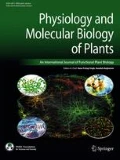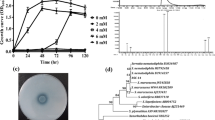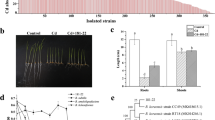Abstract
Cadmium (Cd) is highly toxic metal for plant metabolic processes even in low concentration due to its longer half-life and non-biodegradable nature. The current study was designed to assess the bioremediation potential of a Cd-tolerant phytobeneficial bacterial strain Bacillus sp. SDA-4, isolated, characterized and identified from Chakera wastewater reservoir, Faisalabad, Pakistan, together with spinach (as a test plant) under different Cd regimes. Spinach plants were grown with and without Bacillus sp. SDA-4 inoculation in pots filled with 0, 5 or 10 mg kg−1 CdCl2-spiked soil. Without Bacillus sp. SDA-4 inoculation, spinach plants exhibited reduction in biomass accumulation, antioxidative enzymes and nutrient retention. However, plants inoculated with Bacillus sp. SDA-4 revealed significantly augmented growth, biomass accumulation and efficiency of antioxidative machinery with concomitant reduction in proline and MDA contents under Cd stress. Furthermore, application of Bacillus sp. SDA-4 assisted the Cd-stressed plants to sustain optimal levels of essential nutrients (N, P, K, Ca and Mg). It was inferred that the characterized Cd-tolerant PGPR strain, Bacillus sp. SDA-4 has a potential to reduce Cd uptake and lipid peroxidation which in turn maintained the optimum balance of nutrients and augmented the growth of Cd-stressed spinach. Analysis of bioconcentration factor (BCF) and translocation factor (TF) revealed that Bacillus sp. SDA-4 inoculation with spinach sequestered Cd in rhizospheric zone. Research outcomes are important for understanding morpho-physio-biochemical attributes of spinach-Bacillus sp. SDA-4 synergy which might provide efficient strategies to decrease Cd retention in edible plants and/or bioremediation of Cd polluted soil colloids.




Similar content being viewed by others
6. References
Afridi MS, Amna MT, Salam A, Bibi M, Khan AA, Ali F, Mehmood S, Chaudhary HJ (2018) Induction of salinity tolerance in wheat genotypes by plant growth promoting endophytes: involvement of ACC deaminase and antioxidant enzymes. Plant Physiol Biochem 139:569–577
Ahemad M, Kibret M (2014) Mechanisms and applications of plant growth promoting rhizobacteria: Current perspective. J King Saud Uni Sci 26:1–20
Akram MS, Shahid M, Tariq M, Azeem M, Javed MT, Saleem S, Riaz S (2016) Deciphering Staphylococcus sciuri SAT-17 mediated anti-oxidative defense mechanisms and growth modulations in salt stressed maize (Zea mays L.). Front Microbiol 7:867. https://doi.org/10.3389/fmicb.2016.00867
Al Mahmud J, Hasanuzzaman M, Nahar K, Bhuyan MB, Fujita M (2018) Insights into citric acid-induced cadmium tolerance and phytoremediation in Brassica juncea L.: coordinated functions of metal chelation, antioxidant defense and glyoxalase systems. Ecotoxicol Environ Safe 147:990–1001
Arnon DI (1949) Copper enzymes in isolated chloroplasts: poly phenoloxidase in Beta vulgaris. Plant Physiol 24:1–15
Arnon DI, Hoagland DR (1940) Crop production in artificial culture solution, sand and soil with special reference to factors influencing yield and absorption of inorganic nutrient. Soil Sci 50:463–483
Asif M, Pervez A, Irshad U, Mehmood Q, Ahmad R (2020) Melatonin and plant growth-promoting rhizobacteria alleviate the cadmium and arsenic stresses and increase the growth of Spinacia oleracea L. Plant Soil Environ 66(5):234–241
Bates L, Waldren R, Teare I (1973) Rapid determination of free proline for water-stress studies. Plant Soil 39:205–207
Bradford MM (1976) A rapid and sensitive method for the quantification of microgram quantities of protein utilizing the principle of protein-dye binding. Anal Biochem 72:248–254
Bremner JM, Keeney DR (1965) Steam distillation methods for determination of ammonium, nitrate and nitrite. Anal Chim Acta 32:485–495
Cai Y, Zhang S, Cai K, Huang F, Pan B, Wang W (2020) Cd accumulation, biomass and yield of rice are varied with silicon application at different growth phases under high concentration cadmium-contaminated soil. Chemosphere 242:125–128
Chance B, Maehly AC (1955) Assay of catalase and peroxidase. Method Enzymol 2:764–775
Chary NS, Kamala CT, Raj DSS (2008) Assessing risk of heavy metals from consuming food grown on sewage irrigated soils and food chain transfer. Ecotoxicol Environ Saf 69:513–524
Corguinha APB, de Souza GA, Gonçalves VC, Carvalho CDA, de Lima WEA, Martins FAD, Yamanaka CH, Francisco EAB, Guilherme LRG (2015) Assessing arsenic, cadmium, and lead contents in major crops in Brazil for food safety purposes. J Food Compos Anal 37:143–150
Dabral S, Varma A, Choudhary DK, Bahuguna RN, Nath M (2019) Biopriming with Piriformospora indica ameliorates cadmium stress in rice by lowering oxidative stress and cell death in root cells. Ecotoxicol Environ Safe 186:109741
Din BU, Amna RM, Javed MT, Kamran MA, Mehmood S, Khan M, Sultan T, Munis MFH, Chaudhary HJ (2020) Assisted phytoremediation of chromium spiked soils by Sesbania sesban in association with Bacillus xiamenensis PM14: A biochemical analysis. Plant Physiol Biochem 146:249–258
El-Esawi MA, Al-Ghamdi AA, Ali HM, Alayafi AA (2019) Azospirillum lipoferum FK1 confers improved salt tolerance in chickpea (Cicer arietinum L.) by modulating osmolytes, antioxidant machinery and stress-related genes expression. Environ Exp Bot 159:55–56
El-Esawi MA, Elkelish A, Soliman M, Elansary HO, Zaid A, Wani SH (2020) Serratia marcescens BM1 enhances cadmium stress tolerance and phytoremediation potential of soybean through modulation of osmolytes, leaf gas exchange, antioxidant machinery, and stress-responsive genes expression. Antioxidants 9(1):43
Farhangi-Abriz S, Tavasolee A, Ghassemi-Golezani K, Torabian S, Monirifar H, Rahmani HA (2020) Growth-promoting bacteria and natural regulators mitigate salt toxicity and improve rapeseed plant performance. Protoplasma. https://doi.org/10.1007/s00709-020-01493-1
Gamalero E, Lingua G, Berta G, Glick BR (2009) Beneficial role of plant growth promoting bacteria and arbuscular mycorrhizal fungi on plant responses to heavy metal stress. Can J Microbiol 55:501–514
Gill RA, Zhang NA, Ali B, Farooq MA, Xu J, Gill MB, Mao B, Zhou W (2016) Role of exogenous salicylic acid in regulating physio-morphic and molecular changes under chromium toxicity in black and yellow- seeded Brassica napus L. Environ Sci Pollut Res 23:20483–20496
Glick BR (2014) Bacteria with ACC deaminase can promote plant growth and help to feed the world. Microbiol Res 169:30–39
Gupta P, Diwan B (2017) Bacterial exopolysaccharide mediated heavy metal removal: a review on biosynthesis, mechanism and remediation strategies. Biotechnol Rep 13:58–71
Gupta P, Kumar V, Usmani Z, Rani R, Chandra A (2018) Phosphate solubilization and chromium (VI) remediation potential of Klebsiella sp. strain CPSB4 isolated from the chromium contaminated agricultural soil. Chemosphere 192:318–327
Gururani MA, Upadhyaya CP, Baskar V, Venkatesh J, Nookaraju A, Park SW (2013) Plant growth-promoting rhizobacteria enhance abiotic stress tolerance in Solanum tuberosum through inducing changes in the expression of ROS-scavenging enzymes and improved photosynthetic performance. J Plant Growth Regul 32:245–258
Han H, Cai H, Wang XY, Hu XM, Chen ZJ, Yao LG (2020) Heavy metal-immobilizing bacteria increase the biomass and reduce the Cd and Pb uptake by pakchoi (Brassica chinensis L.) in heavy metalcontaminated soil. Ecotoxicol Environ Safe 195:110375
Heath RL, Packer L (1968) Photoperoxidation in isolated chloroplasts: I. Kinetics and stoichiometry of fatty acid peroxidation. Arch Biochem Biophys 125:189–198
Hussain A, Amna KMA, Javed MT, Hayat K, Farooq MA, Ali A, Ali M, Manghwar H, Jan F, Chaudhary HJ (2019) Individual and combinatorial application of Kocuria rhizophila and citric acid on phytoextraction of multi-metal contaminated soils by Glycine max L. Environ Exp Bot 159:23–33
Iqbal N, Khan NA, Ferrante A, Trivellini A, Fracini A, Khan MIR (2017) Ethylene role in plant growth, development and senescence: Interaction with other phytohormones. Front Plant Sci 8:475
Islam F, Yasmeen T, Riaz M, Arif MS, Ali S, Raza SH (2014) Proteus mirabilis alleviates zinc toxicity by preventing oxidative stress in maize (Zea mays) plants. Ecotoxicol Environ Safe 110:143–152
Javed MT, Greger M (2011) Cadmium triggers Elodea canadensis to change the surrounding water pH and thereby Cd uptake. Int J Phytoremediat 13:95–106
Jian L, Bai X, Zhang H, Song X, Li Z (2019) Promotion of growth and metal accumulation of alfalfa by coinoculation with Sinorhizobium and Agrobacterium under copper and zinc stress. Peer J 7:e6875
Julkunen-Tiitto R (1985) Phenolic constituents in the leaves of northern willows: methods for the analysis of certain phenolics. J Agric Food Chem 33:213–217
Kaymak HC (2011) Potential of PGPR in agricultural innovations. In: Maheshwari DK (ed) Plant growth and health promoting bacteria. Springer, Berlin, pp 45–79
Khan A, Sirajuddin ZXQ, Javed MT, Khan KS, Bano A, Shen RF, Masood S (2016) Bacillus pumilus enhances tolerance in rice (Oryza sativa L.) to combined stresses of NaCl and high boron due to limited uptake of Na+. Environ Exp Bot 124:120–129
Khan MY, Prakash V, Yadav V, Chauhan DK, Prasad SM, Ramawat N, Sharma S (2019) Regulation of cadmium toxicity in roots of tomato by indole acetic acid with special emphasis on reactive oxygen species production and their scavenging. Plant Physiol Biochem 142:193–201
Khanna K, Jamwal VL, Gandhi SG, Ohri P, Bhardwaj R (2019) Metal resistant PGPR lowered Cd uptake and expression of metal transporter genes with improved growth and photosynthetic pigments in Lycopersicon esculentum under metal toxicity. Sci Rep 9:5855
Küpper H, Kochian LV (2010) Transcriptional regulation of metal transport genes and mineral nutrition during acclimatization to cadmium and zinc in the Cd/Zn hyperaccumulator, Thlaspi caerulescens (Ganges population). New Phytol 185:114–129
Kurtyaka R, Małkowski E, Kita A, Karcz A (2008) Effect of calcium and cadmium on growth and accumulation of cadmium, calcium, potassium and sodium in maize seedlings. Pol J Environ Stud 17:51–56
Lux A, Martinka M, Vaculík M, White PJ (2011) Root responses to cadmium in the rhizosphere: A review. J Exp Bot 62:21–37
Malook I, Rehman SU, Khan MD, El-Hendawy SE, Al-Suhaibani NA, Aslam MM, Jamil M (2017) Heavy metals induced lipid peroxidation in spinach mediated with microbes. Pak J Bot 49(6):2301–2308
Mohite B (2013) Isolation and characterization of indole acetic acid (IAA) producing bacteria from rhizospheric soil and its effect on plant growth. J Sci Plant Nutr 13:638–649
Ojuederie OB, Babalola OO (2017) Microbial and Plant-Assisted Bioremediation of Heavy Metal Polluted Environments: A Review. Int J Environ Res Public Health 14:1504
Penrose DM, Glick BR (2003) Methods for isolating and characterizing ACC deaminase-containing plant growth-promoting rhizobacteria. Physiol Plant 118:10–15
Pikovskaya RI (1948) Metabolism of phosphorous in soil in connection with vital activity of some microbial species. Microbiologia 17:362–370
Ramakrishna W, Rathore P, Kumari R, Yadav R (2020) Brown gold of marginal soil: Plant growth promoting bacteria to overcome plant abiotic stress for agriculture, biofuels and carbon sequestration. Sci Total Environ 711:135062
Richards SL, Wilkins KA, Swarbreck SM, Anderson AA, Habib N, Smith AG, McAinsh M, Davies JM (2015) The hydroxyl radical in plants: from seed to seed. J Exp Bot 66(1):37–46
Rizwan M, Ali S, Abbas T, Adrees M, Zia-ur-Rehman M, Ibrahim M, Nawaz R (2018) Residual effects of biochar on growth, photosynthesis and cadmium uptake in rice (Oryza sativa L.) under Cd stress with different water conditions. J Environ Manage 206:676–683
Sarwar N, Malhi SS, Zia MH, Naeem A, Bibi S, Farid G (2010) Role of mineral nutrition in minimizing cadmium accumulation by plants. J Sci Food Agric 90:925–937
Shahid M, Akram MS, Khan MA, Zubair M, Shah SM, Ismail M, Shabir G, Basheer S, Aslam K, Tariq M (2018) A phytobeneficial strain Planomicrobium sp. MSSA-10 triggered oxidative stress responsive mechanisms and regulated the growth of pea plants under induced saline environment. J Appl Microbiol 124:1566–1579
Shahid M, Hameed S, Imran A, Ali S, Elsas JDV (2012) Root colonization and growth promotion of sunflower (Helianthus annuus L.) by phosphate solubilizing Enterobacter sp. Fs-11. World J Microbiol Biotechnol 28:2749–2758
Shahid M, Hameed S, Tariq M, Zafar M, Ali A, Ahmad N (2015) Characterization of mineral phosphate-solubilizing bacteria for enhanced sunflower growth and yield attributing traits. Ann Microbiol 65:1525–1536
Shahid M, Javed MT, Masood S, Akram MS, Azeem M, Ali Q, Gilani R, Basit F, Abid A, Lindberg S (2019) Serratia sp. CP-13 augments the growth of cadmium (Cd)-stressed Linum usitatissimum L. by limited Cd uptake, enhanced nutrient acquisition and antioxidative potential. J Appl Microbiol 126(6):1708–1721
Shahid M, Shah AA, Basit F, Noman M, Zubair M, Ahmed T, Naqqash T, Manzoor I, Maqsood A (2020) Achromobacter sp FB-14 harboring ACC deaminase activity augmented rice growth by upregulating the expression of stress-responsive CIPK genes under salinity stress. Braz J Microbiol. https://doi.org/10.1007/s42770-019-00199-8
Singh S, Singh VP, Prasad SM, Sharma S, Ramawat N, Dubey NK, Chauhan DK (2019) Interactive effect of silicon (Si) and salicylic acid (SA) in maize seedlings and their mechanisms of cadmium (Cd) toxicity alleviation. J Plant Growth Regul 38(4):1587–1597
Somasegaran P, Hoben HJ (1994) Handbook for rhizobia: Methods in legumerhizobium technology. Springer, Heidelberg, NY
Spaepen S, Vanderleyden J, Remans R (2007) Indole-3-acetic acid in microbial and microorganism-plant signaling. FEMS Microbiol Rev 31:425–448
Steel RGD, Torrie JH, Dickey DA (1997) Principles and procedures of statistics, a biometrical approach, 3rd edn. McGraw-Hill Co., Inc., New York NY
Sterckeman T, Redjala T, Morel JL (2011) Influence of exposure solution composition and of plant cadmium content on root cadmium short-term uptake. Environ Exp Bot 74:131–139
Sytar O, Kumari P, Yadav S, Brestic M, Rastogi A (2018) Phytohormone priming: regulator for heavy metal stress in plants. J Plant Growth Regul 1–14
Tien TM, Gaskins MH, Hubbell DH (1979) Plant growth substances produced by Azospirillum brazilense and their effect on the growth of pearl millet. Appl Environ Microbiol 37:1016–1024
Wan Y, Luo S, Chen J, Xiao X, Chen L, Zeng G, Liu C, He YE (2012) Effect of endophyte-infection on growth parameters and Cd-induced phytotoxicity of Cd-hyperaccumulator Solanum nigrum L. Chemosphere 89:743–750
Wang Q, Chen L, He LY, Sheng XF (2016) Increased biomass and reduced heavy metal accumulation of edible tissues of vegetable crops in the presence of plant growth-promoting Neorhizobium huautlense T1–17 and biochar. Agric Ecosyst Environ 228:9–18
Wang T, Wang X, Tian W, Yao L, Li Y, Chen Z, Han H (2020) Screening of heavy metal-immobilizing bacteria and its effect on reducing Cd2+ and Pb2+ concentrations in water spinach (Ipomoea aquatic Forsk.). Int J Env Res Pub He 17(9):3122
Weisburg WG, Barns SM, Pelletier DA, Lane DJ (1991) 16S ribosomal DNA amplification for phylogenetic study. J Bacteriol 173:697–703
Wilson K (2001) Preparation of genomic DNA from bacteria. Curr Protoc Mol Biol 56:2–4
Yasmeen T, Ali Q, Islam F, Ali N, Akram MS, Javed MT (2014) Biologically treated wastewater fertigation induced growth and yield enhancement effects in Vigna radiata L. Agric Water Manag 146:124–130
Yildirim E, Karlidag H, Turan M, Dursun A, Goktepe F (2011) Growth, nutrient uptake, and yield promotion of broccoli by plant growth promoting rhizobacteria with manure. Hort Sci 46:932–936
Younis U, Malik SA, Rizwan M, Qayyum MF, Ok YS, Shah MHR, Rehman RA, Ahmad N (2016) Biochar enhances the cadmium tolerance in spinach (Spinacia oleracea) through modification of Cd uptake and physiological and biochemical attributes. Environ Sci Pollut Res 23:21385–21394
Zafar-ul-Hye M, Tahzeeb-ul-Hassan M, Abid M, Fahad S, Brtnicky M, Dokulilova T, Danish S (2020) Potential role of compost mixed biochar with rhizobacteria in mitigating lead toxicity in spinach. Sci Rep 10(1):1–12
Zaidi A, Khan M, Ahemad M, Oves M (2009) Plant growth promotion by phosphate solubilizing bacteria. Acta Microbiol Immunol Hung 56:263–284
Acknowledgements
We gratefully acknowledge the provision of funds by Higher Education Commission (HEC) of Pakistan (Grant No: 20-4243/NRPU/R&D/HEC/14/885). The results presented in this paper are the part of MPhil research work of Ms. Sadia Mujtaba.
Author information
Authors and Affiliations
Contributions
MTJ, MS and MSA, planning of study; KT and SM, experimental work; SKT and MHS, statistical analysis and critically review; HJC and SM, data discussion. All the authors approved the final version of the manuscript.
Corresponding author
Ethics declarations
Conflict of interest
The authors declare that they have no conflict of interest.
Additional information
Publisher's Note
Springer Nature remains neutral with regard to jurisdictional claims in published maps and institutional affiliations.
Rights and permissions
About this article
Cite this article
Shahid, M., Javed, M.T., Tanwir, K. et al. Plant growth-promoting Bacillus sp. strain SDA-4 confers Cd tolerance by physio-biochemical improvements, better nutrient acquisition and diminished Cd uptake in Spinacia oleracea L.. Physiol Mol Biol Plants 26, 2417–2433 (2020). https://doi.org/10.1007/s12298-020-00900-4
Received:
Revised:
Accepted:
Published:
Issue Date:
DOI: https://doi.org/10.1007/s12298-020-00900-4




